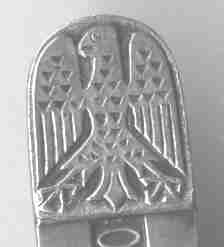Periodically spoons were created for a specific cause or event. When I first purchased this spoon I suspected that this was the case, but once I had done the research, I found that there was significantly deeper meaning to this spoon.
In brief, Victor (Viktor) Schauberger was an eccentric genious engineer and philospher in Austria during the 1920 - 1930 period. Based upon his observations of water and animals combined with his philosophical bent he became one of the very first "Greens" (environmentalists) in Central Europe. One of his major treatises included the concept of saving the Rhine and Danube rivers from environmental abuse and to produce a better usage of their water. This spoon was related to his efforts.


This art deco style spoon features an imperial eagle chased into the finial. The handle is marked "Frei Der Rhein" (Save the Rhine) with the date of July 1, 1930. This 5" spoon has German silver marks. Note there is a steep bend in the handle just before the bowl begins so that the spoon could be used as a scoop.
Herr Schauberger was a prolific writer , thinker and noted personality in his day . There are a number of web sites which contain extensive naratives of his philosophies, inventions, and details of his life before, during and after World War ll.
Normally I just provide a synopsis of the research information which I find. However, in this case the amount of information is so extensive and detailed, and some of the details were troubling to me, so I have quoted extensively and provided a link for those desiring more information (see below).
He philosophized about what he observed in nature.
"How was it (trout) able to flee upstream like a streak of greased lightning in mockery of all the laws of gravity? How was it possible for this fish to stand so motionlessly, only steering itself with slight movements of its tail-fins, in this wildly torrential flow, which made my staff shake so much that I could hardly hang onto it?
"What forces enabled the trout to overcome its own body-weight so effortlessly and quickly and at the same time overcome the specific weight of the heavy water flowing against it? Why didn't the water freeze even during periods of severe frost with temperatures below -30°C?"
"He claimed, and rightly so, that by and large we human beings are extremely superficial, looking for and only seeing direct relations between cause and effect, whereas Nature always moves indirectly. But worse than this, in our ignorance of the unseen dynamic behind the seen manifestation, we mistake the effect for the cause, greatly compounding this error by failing to see that an effect becomes the cause for a further effect in an endless chain of causes and effects."
"Our thinking is inconsistent with what we actually see. The eye is a perfect, natural organ. The seen image is a reaction phenomenon. Using an artificial optical apparatus the same effect, for example, can only be obtained by a roundabout way, by means of a negative. The eye, on the other hand, immediately presents us with the diapositive, namely the true image."
"Our sight constitutes an unconscious, automatic transformation process, through which the negative image -- like a photographic negative -- i.e. the effect, is transformed into a positive one, like a diapositive colour slide. Our thinking, however, is really a purely individual, conscious process and therefore learnable. If our thinking is to attain the same perfection as our seeing, then we must change our way of thinking and learn to see reality, not as an action, but as a reaction. Perfect thought lies in the apprehension of the correct reaction, for before the eye can show us the positive, it must first transform the negative and in a certain manner must break up what it records. What we see therefore, is the turning inside out of what we receive. What our mind grasps in this way must be re-formed and re-thought if we wish to attain what we strive for."
"Always a thorn in the side of scientific and government institutions, Viktor's long battle to save both the Rhine and the Danube from total ruin was ultimately lost through their rejection of his practical suggestions. In early 1932 he wrote a paper about the rehabilitation of the Danube detailing the measures that needed to be taken in order to reinstate it as the magnificent river it had been in days of yore. This paper was included as a separate chapter in "The Danube", a study undertaken by the International Danube Commission and consisting of submissions from the Danube's various contiguous countries."
The information about him, his philosophy and his life is extensive, but if you have more interest you can go to the source by "clicking here".